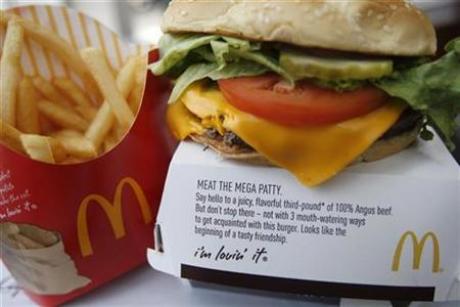Fast-food restaurants target U.S. kids, study shows
(Agencies)
Updated: 2010-11-09 09:08
 |
Large Medium Small |

Fast-food restaurants are stepping up efforts to market themselves and unhealthy food products to children and toddlers with television ads, websites and even their own menus, researchers said on Monday.
They said efforts by the industry to regulate itself have failed and urged government officials at all levels to declare children a protected group and stop marketing efforts that are fueling child obesity, a serious U.S. health problem.
"What we found in the marketing data is a staggering amount of fast-food advertising that starts when children are as young as 2 years old," Jennifer Harris, of the Yale University Rudd Center for Food Policy & Obesity in Connecticut, told a telephone briefing.
Harris and colleagues spent a year studying 12 big fast-food chains, analyzed the calories, fat, sugar and sodium in menu items and kids' meal combinations, and studied what children and teens ordered.
The report, available at www.fastfoodmarketing.org, finds the industry spent more than $4.2 billion in 2009 on marketing and advertising on television, the Internet, social media sites and mobile applications.
"Despite pledges to improve their marketing practices, fast food companies seem to be stepping up their efforts to target kids," Harris said.
"Today, preschoolers see 21 percent more fast food ads on TV than they saw in 2003, and somewhat older children see 34 percent more."
McDonald's Corp has 13 websites, attracting 365,000 unique child visitors under 12 every month. One, ronald.com, specifically targets preschoolers.
The U.S. Centers for Disease Control and Prevention says two-thirds of American adults and 15 percent of children are overweight or obese. In some states, the childhood obesity rate is above 30 percent.
HEALTHIER CHOICES
U.S. first lady Michelle Obama, spearheading an administration initiative on child obesity, has urged food manufacturers to re-package food so that it is healthier for kids.
In 2007, McDonald's and other large U.S. food and drink companies pledged to adopt stricter controls on advertising to children under 12.
"Most restaurants will say that they have added healthier choices to their menus in recent years," Yale's Marlene Schwartz, who worked on the study, told the briefing.
"In most cases you have to work very hard to get a healthy side or drink in a fast-food restaurant," Schwartz said. "You have to know it exists and you have to ask for it."
Burger King in a statement said it "has strengthened its commitment in this area since 2007 by enhancing its nutrition criteria for advertised Kids Meals," including lowered sodium.
McDonald's said it had kept its promises. "We primarily advertise our popular 375 calorie four-piece Chicken McNugget Happy Meal which includes Apple Dippers, low-fat caramel dip, and a jug of 1 percent low-fat milk," spokesman Neil Golden said in a statement.
The researchers found that teenagers purchased 800 to 1,100 calories, or half a day's worth, in an average visit.
Yale's Kelly Brownell said state and local governments can rein in the marketing behavior of the restaurants, pointing to San Francisco's law passed last week that cracks down on giving away toys in children's meals.
Brownell hopes Monday's report will do more.
"There will be a level of anger, even rage perhaps, that will set the stage for legislation and even regulatory action," he said.